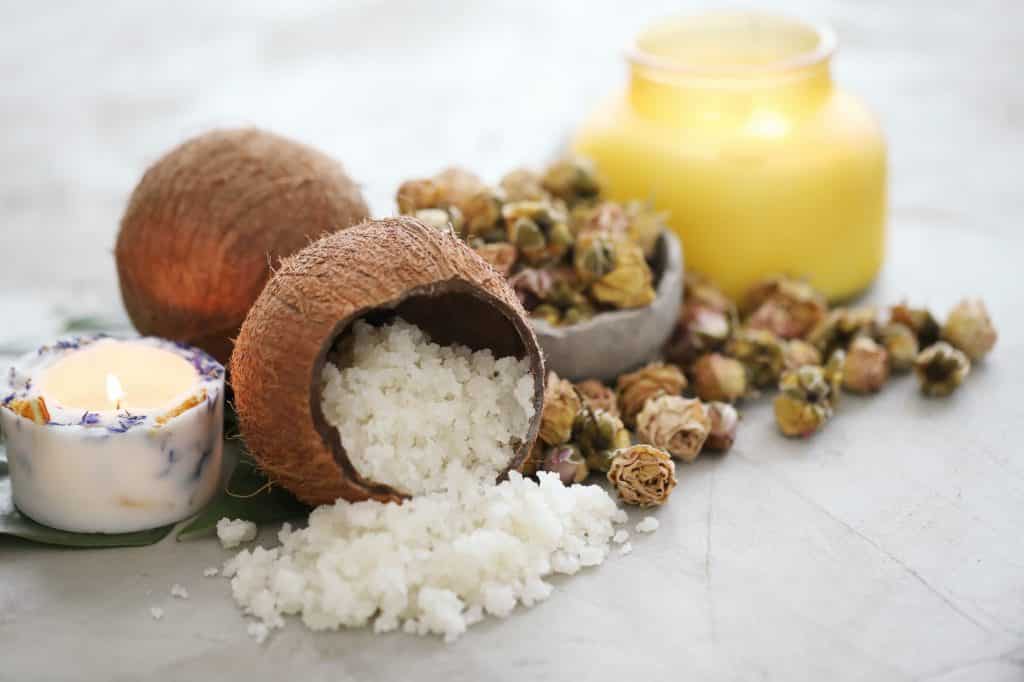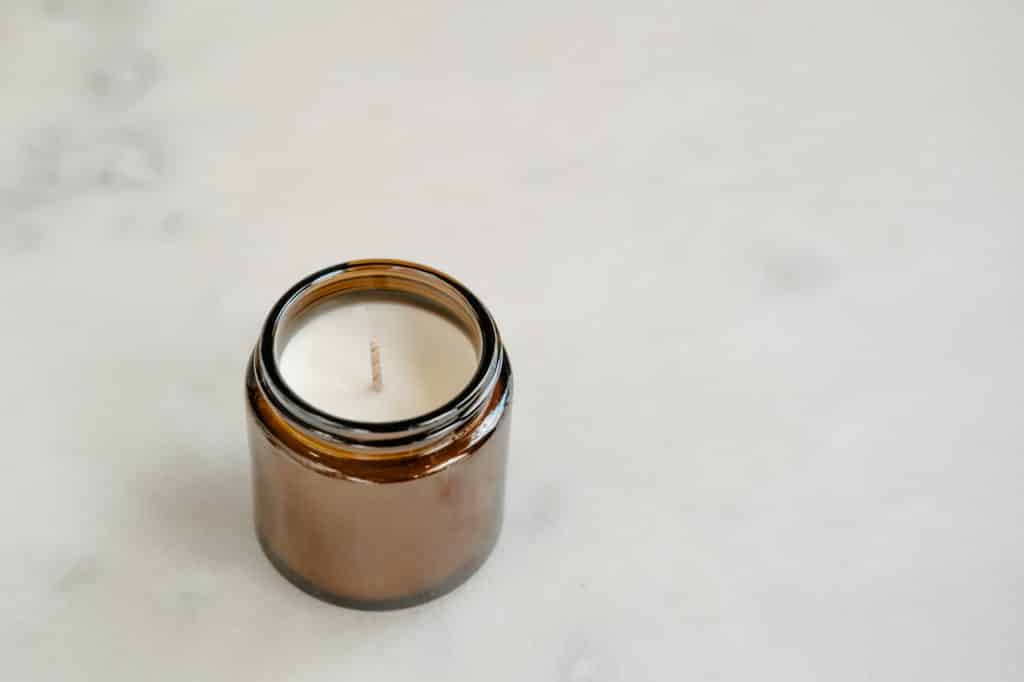Coconut wax and other types of natural waxes have risen in popularity over the years, but they’re not always the best wax for the type of candle you’re making. Before you invest in any wax, it’s important to be sure that it will be the right one for your needs.
Today, we’ll talk more about the pros and cons of coconut wax candles.

Pros and Cons of Coconut Wax Candles
The Pros:
Coconut wax is a sustainable material that burns cleaner than many other types of traditional candles. It’s a soft wax, making it an ideal choice for almost any kind of candle going in a container.
This soft wax usually makes great melt-and-pour projects quick and easy (though, like most natural waxes, they have a longer curing time).
With coconut wax candles, you get a burn that lasts longer than most paraffin waxes and paraffin blends. Coconut wax candles might be expensive, but you won’t go through them nearly as quickly as you will paraffin ones.
Its almost pure-white color makes it a great choice for natural colorants that might not hold up very well in waxes with yellow tints (like yellow beeswax).
It also doesn’t really have a scent, making it perfect for adding your favorite scents without interference. (I personally still love the smell of a nice beeswax candle, but its natural scent can get in the way of more subtle essential oils if you’re using those in your candles.)
Coconut wax possibly offers the best scent throw of all the natural waxes. You’ll see it work its way into soy wax blends and other natural wax blends to get a better scent and help stabilize the coconut wax. (More on this below.)
Lastly, between things like paraffin and palm wax, many people have been moving away from candles due to health concerns and their negative impact on the environment. Coconut wax is possibly the most eco-friendly and sustainable option on the market.
But as with all things, coconut wax does have its downsides, which we’ll get into below.
Depending on how you make your candles and what type of projects you’re interested in, some of these might be a deal-breaker! We’ll also cover some alternatives that will allow you to stick with healthy, eco-friendly options.

The Cons:
The single biggest con of coconut wax isn’t so much due to the wax itself, but due to the lack of transparency from manufacturers and the tricky language they use (and sometimes outright lies).
Amidst all the craze among “all-natural” candle makers to get their hands on coconut wax comes a big problem—lack of education and being too trusting of manufacturers. Unfortunately, in this industry, you have to use quite a bit of discernment and be very wary of new products and sources.
It’s actually pretty difficult to get your hands on pure coconut wax for a few reasons. It’s costly, not the most practical of waxes for people that are shipping their candles, and most coconut wax on the market is some sort of blend.
That’s not to say all coconut wax blends are bad! This brings us to the next big con of coconut wax:
The melting point.
Coconut wax is a very soft wax that has a much lower melting point than most waxes. This makes them a bit tricky to ship, especially during the summer. Just a bit of summer heat is enough to ruin a pure coconut wax candle in transit.
For that reason, you’ll find that most coconut wax is actually blended with beeswax, soy, or paraffin wax to help stabilize it and keep it from melting so easily. (One of the blends I recommend for candlemaking is actually a soy/coconut blend, which I’ve included below.)
If you’re just concerned with making your candles with ingredients known to be safe and natural, the first two are fine! But obviously, you don’t want paraffin getting in the mix, which happens far more often than it should.
The issue often lies with the manufacturer rather than your favorite candlemaker. Especially in an industry with few regulations on labeling and safety requirements, you tend to run into a lot of issues with candlemakers not really knowing what’s in their candles, particularly when they don’t have the testing resources of larger candlemaking companies.
You can mitigate this with a bit of research on the company you’re buying from. Go through reviews, ask more experienced makers for their recommendations, and get in touch with the manufacturer (or other candle companies who aren’t selling in your area!).
The last con: you’re a bit limited in what types of candles you can make.
You’re definitely not going to be making taper, pillar, or any other freestanding candle with coconut wax. Even most coconut wax blends are far too soft for that.
For freestanding candles, you’re better off looking at beeswax or other similar blends that hold up better to heat. While it can have a strong scent, beeswax makes wonderful wax for pillar candles or carving projects.
- THE ORIGINAL WOODEN WICK: The Wooden Wick Co. is the authentic creator and exclusive distributor of the original wooden wick. Our wicks burn smokeless and cleaner compared to the traditional cotton wick.
- ENHANCED PERFORMANCE: Our #1 selling Virgin Coconut Soy wax has been enhanced to perform even better by featuring fuller adhesion, smoother tops after initial pour, skin-safe, and now contains a heat antioxidant to protect the color of your wax after each burn.
- WAX PROPERTIES: This wax can typically holds 9-10% fragrance, but can safely hold up to 12% fragrance. It has a melting point of 122 fahrenheit and an ideal pouring temperature ranges from 180-190 fahrenheit.
- CREATE A UNIQUE ATMOSPHERE: Our wooden candle wicks create a unique fireside atmosphere that will elevate any candle without any additional treatments, soaking or doubling up. Start making your candle by securing the metal holder to the jar and melting the soy wax.
- BUILT FOR CREATORS: The Wooden Wick Co. was built for creators like you, by creators like you. We exist with a mindful mission; to elevate, educate, and inspire by providing unique, innovative products and resources to help you succeed. Through collective empowerment, trend-setting assortments, eco-friendly offerings and charitable initiatives, we stand to enlighten and uplift Makers globally.
- ✅ ALL NATURAL BLEND: Craft and create exceptional scented candles using the best ingredients that nature has to offer. Say hello to our blend of coconut and soy wax, your next favorite candle wax base. Now, you can enjoy the slow and clean burning qualities and exceptional scent throws of both soy and coconut wax in one wax blend.
- ✅ BETTER SCENT THROW: With a melting point at 120(°F), our wax has great scent throw. The addition of coconut wax also means that this wax blend can better diffuse fragrances throughout a room. Candles created with this blend of soy and coconut wax are ideal for aromatherapy.
- ✅ VERSATILE: Our wax has a pouring point of 167(°F) and works well with a number of essential oils. You can easily mix and match different scents to come up with your own signature fragrances for your candle making project.
- ✅ ECO-FRIENDLY: Hearts & Crafts waxes are some of the most eco-friendly candle wax options out there. After all, soybeans and coconuts are 100% natural, sustainable, and easily renewable crops. Moreover, both soy and coconut wax are biodegradable.
- ✅ COMPLETE KIT: Our set of candle making supplies already has everything you need to get started making candles. It includes 10 lbs of wax, 50 wicks, and 3 centering devices so you can just let your creativity flow. The wax in this kit is a coconut wax blend with soy wax.
Ready to get started?
Check out some of our other articles on candle making and choosing the best wax and scents for candle making. And if you have any photos, we’d love to see your projects! Feel free to link them in the comments below.









